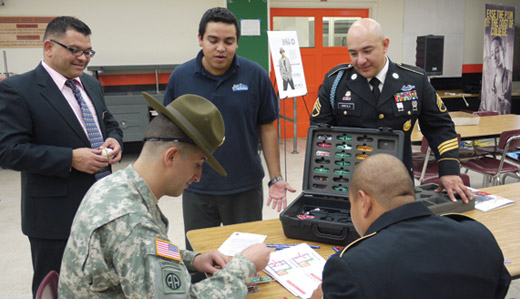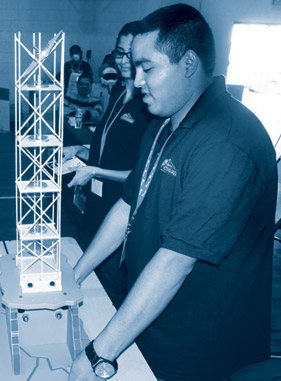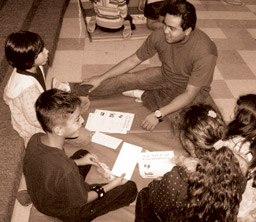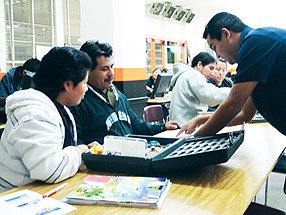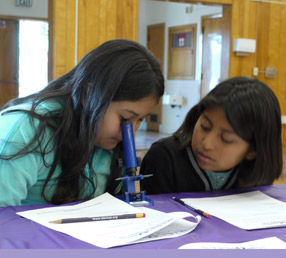It Takes A Community
BY MARGARET LOFTUS
Role models, peers, and parents are key to a program drawing underserved students into STEM.
As a sophomore at Manual Arts High School in South Central Los Angeles, Bayron Lopez had set his sights on becoming a lawyer. But that changed after he heard Lockheed Martin aerospace engineer Manny Sanchez speak at a school workshop designed to promote careers in science, math, engineering, and technology (STEM). “I was amazed by the possibilities that were available in engineering, and I said, ‘I want to do that!’”
Lopez, who was born in El Salvador, is now studying mechanical engineering and education as a junior at California State University, Los Angeles. What’s more, he volunteers to spread the word about engineering to middle and high school students for Viva Technology, the same outreach program for Hispanic and other underrepresented students that brought Sanchez to his school six years ago. “Knowing that I helped somebody and giving them ideas for the future, it’s amazing for me,” he says.
That Lopez has taken this path thrills the team at Great Minds in STEM (GMiS), an L.A.-based nonprofit that coordinates Viva Technology events with help from corporate and government sponsors such as Motorola and the Department of Defense, school districts, industry professionals, and college volunteers. Founded in 1989 by Ray Mellado, then a national sales manager at Xerox, to recognize the achievements of Latino STEM professionals, GMiS introduced Viva Technology in 2001. Last year, GMiS kicked off its third component, the STEM-Up Initiative, a pilot project in East L.A.’s predominantly Hispanic Boyle Heights neighborhood. STEM-Up aims to pick up where Viva leaves off, by integrating STEM career pathways in K-12 through hands-on activities, teacher workshops, parents’ nights, and community outreach. GMiS is a partner with ASEE on several K-12 initiatives.
A Troubling Gap
While stories like Lopez’s are encouraging, GMiS is still fighting an uphill battle. Hispanics already make up 15.8 percent of the population, and their numbers are growing faster than any other segment. By 2050, 1 in 4 Americans will be Hispanic, the Census Bureau estimates. Yet they now comprise just over 5 percent of the engineering workforce in the United States. The gap is particularly worrisome, given that the manufacturing jobs that have long sustained first- and second-generation immigrants are disappearing. “Technology is where the jobs are going to be. I don’t think our community has made that transition,” says Mellado. “I really feel if our community is technically prepared, they’re going to be successful.”
The implications of the gap go beyond the Latino community, argues GMiS Vice Chair Robert Amezcua, a retired IBM vice president. As the current generation of engineers retires, the country will have an increasing need to tap Hispanics. “If we don’t educate that population and raise their awareness, our technological lead will be in jeopardy,” he argues.
Why do so few Latinos enter STEM professions in the first place? “Their families, especially the inner city and rural poor, don’t have the role models,” Mellado explains. “So there’s a huge disconnect between science and math and what it leads to as a career.” Case in point: When Fred Quintrell, a teacher at Hollenbeck Middle School, a math, science, and technology magnet school in Boyle Heights, asks his seventh graders at the beginning of each year to name a career in science, they inevitably reply “scientist,” “teacher,” or to lesser degree, “doctor.” “They’re pretty oblivious to the outside world,” he says.
Back in the 1980s, however, Mellado launched an engineering awareness campaign – not with kids but among the smattering of Latinos already in the STEM workforce. With support from his employer Xerox, he became involved in strengthening the network of STEM professionals in the Latino community and went on to found the Hispanic Engineer National Annual Awards Conference (HENAAC), an annual event that honors the best and brightest Hispanic STEM professionals. “It was designed so our college students would have mentors,” Mellado explains. “That really hit. The need was such that it was like drinking out of a fire hose.”
After taking a year long sabbatical from Xerox to build the organization, Mellado decided to devote himself full time to HENAAC, moving the headquarters from Baltimore to L.A. “If we were going to be effective, we had to create an infrastructure,” he says. “I’m a very competitive person; I very much looked at it as a coach trying to win a game.” While the conference itself retains the acronym HENAAC, the organization itself evolved into the umbrella GMiS.
Today, HENAAC receives more than 150 nominees a year from corporations and government agencies for awards in various categories, which are then judged by a selection committee of industry professionals, academics, and government officials. The program is more relevant than ever, says GMiS Executive Director Anna Park. “There are more images and references in the media that portray Hispanics negatively – as drug dealers, gang members, and roles that are negative for society. In fact, Hispanics have and continue to contribute greatly to all aspects of society, whether in the political arena, education, military, law, STEM, medicine, sports, or entertainment.”
As it evolved, HENAAC developed a scholars program that awards grants of $500 to $4,000 to Hispanic undergraduates and graduate students pursuing STEM careers. So far, the program has distributed more than $1 million in grant money. And each year, 1,500 students are selected to attend the annual conference, which this year will be held in October, during Hispanic Heritage Month, in Orlando, Fla., its first time on the East Coast. The invitation is a coveted one for the students, whose traveling expenses are covered by HENAAC, since the student-professional ratio is typically 1-to-1. “We’ve had many college students say they were thinking of dropping out, and they get inspired [at the conference],” says Park. “Sometimes we need to see other people who are successful in what they’re doing to inspire us.”
But as the HENAAC team began to work with undergrads, they found they couldn’t ignore K-12 students. The realization inspired Viva Technology, which GMiS introduced in 2001. What began as a one-day workshop to introduce STEM careers to Hispanic schools around L.A. has spread to underserved communities in 13 states, including New Orleans and Atlanta, where the audience is made up mostly of African-American students.
The day before a typical workshop, teachers are invited to an orientation to hear about the need for STEM professionals and the various resources available to them through GMiS sponsors. Parents, many of whom haven’t been to college and may not be aware of opportunities such as special summer camps, are also invited to learn more about the opportunities in STEM careers and the basics of applying to college.
Viva brings in speakers and peer mentors to match the demographics of the school. On the day of the workshop, 100 middle or high school students are divided up into 10 teams, with a college captain assigned to each. What ensues for much of the day is a high-energy competition among teams to come up with solutions to a hands-on engineering problem, such as calculating the amount of power a wind turbine generates. Prizes such as digital cameras, iPods, and a laptop provide added incentive. The afternoon culminates with a talk by an industry professional about what it’s like to work in a STEM field.
Can You Change the Outcome?
With the addition of new sponsors, such as Boeing and the U.S. Coast Guard, Adalina Rodrequez, who heads up the Viva program, foresees the number of events doubling or tripling from the 20 offered last year. Because of the nature of the program – essentially to promote awareness – its impact had been difficult to quantify, says Park. Nonetheless, anecdotal evidence of its success abounds. “A community is being built around the program,” notes Rodrequez. “We’ve had a lot of students who have been in the program returning to volunteer as college students or professionals.”
Now GMiS is working to further develop a comprehensive program with the Department of Defense that aims to create “a STEM culture” by targeting younger children, teachers, parents, and the community itself. In its second year as a pilot program in Boyle Heights, the STEM-Up Initiative sponsors two hands-on activities a year beginning in the fourth grade. The earlier you can get kids thinking about science, the better, says Mellado. “Our data tells us that if they don’t have Algebra 1 by eighth grade, the chances of them going into a STEM career go way, way down.” Amezcua adds, “Think about sports: That’s when they start. We don’t have that pipeline of development for technology that the sports world has. That’s what we need.”
GMiS distributes 18,000 bilingual profiles of “role models of the month” for teachers to discuss with their students. The Viva program is also offered twice a year to eighth graders and high school students. “We try to touch them five years in a row,” explains Amezcua. To reinforce the message of the opportunities available through STEM, GMiS sponsors parents meetings to talk about career planning and community activities, like library astronomy nights.
Teacher workshops, in conjunction with Cal State, L.A., are held in the summer, with several follow-ups throughout the school year. Last year, Quintrell was one of 18 teachers who spent a week in a lab at Cal State working on experiments, including building a solar oven. “The objective wasn’t for us to build these things; it was for us to think through application in the classroom.” All in all, it was a week well spent, Quintrell says. “You try to introduce students to things they can see themselves doing in the future. Now I have extra added resources to introduce them to engineering.”
GMiS hopes one day to expand STEM-Up and has hired an outside evaluation team to measure its success, but results are a couple of years away. GMiS Director of Education Jennifer Cano is optimistic. “If you invest this level of resources in a community, can you actually change the outcome? That’s what we hope to know.”
Margaret Loftus is a freelance writer based in Boston.
Category: Features
